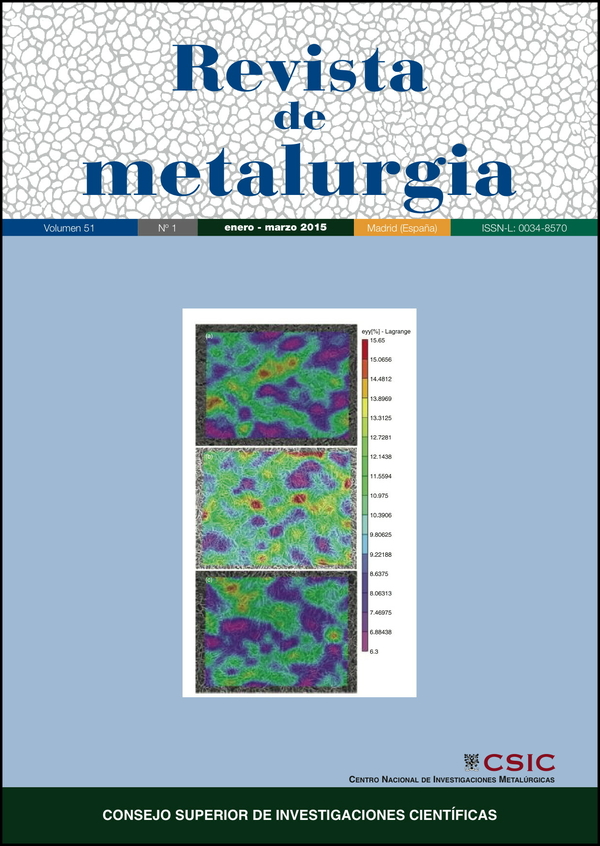The evaluation of different environments in ultra-high frequency induction sintered powder metal compacts
DOI:
https://doi.org/10.3989/revmetalm.036Keywords:
Induction, Iron, Powder metal compact, Sintering, Ultra-high frequency induction sinteringAbstract
The application of the iron based Powder Metal (PM) compacts in Ultra-High Frequency Induction Sintering (UHFIS) was reviewed for different environments. The three different environments: atmosphere, argon and vacuum were applied to the PM compacts. Iron based PM compacts were sintered at 1120 °C for a total of 550 seconds by using induction sintering machines with 2.8 kW power and 900 kHz frequency. Micro structural properties, densities, roughness and micro hardness values were obtained for all environments. The results were compared with each other.
Downloads
References
Çivi, C., Tahralı, N., Atik, E. (2014). Reliability of mechanical properties of induction sintered iron based powder metal parts. Mater. Design (53), 383–397. http://dx.doi.org/10.1016/j.matdes.2013.07.034
Çavdar, U. (2014). Mechanical Properties of Hot Forged ANSI 1050 Steel. Materials Testing 56 (3), 208–212. http://dx.doi.org/10.3139/120.110555
Çavdar, U., Atik, E. (2014a). Investigation of conventional and induction sintered iron and iron based powder metal compacts. JOM 66 (6), 1027–1034. http://dx.doi.org/10.1007/s11837-014-0977-0
Çavdar, U., Atik, E. (2014b). Properties of Boronized, Carbonitrided and Steamed Iron-Based Compacts. Materials Testing 56 (2), 126–130. http://dx.doi.org/10.3139/120.110533
Çavdar, U., Unlu, B.S., Atik, E. (2014a). Effect of the copper amount in iron-basedpowder-metal compacts. Materiali in tehnologije/ Materials and technology 49 (1), 57–62.
Çavdar, U., Atik, E., Ataç, A. (2014b). Mechanical properties and hardness results of the medium frequency induction sintered iron based powder metal bushings. Sci. Sinter. 46 (2), 195–203. http://dx.doi.org/10.2298/SOS1402195C
Çavdar, U., Gu.lsahin, I˙. (2014). Ultra high frequency induction welding of powder metal compacts. Rev. Metal. 50 (2), e016. http://dx.doi.org/10.3989/revmetalm.016
Çavdar, U.,Unlu, B.S., Pinar, A.M., Atik, E. (2015). Mechanical properties of heat treated iron based compacts. Materials & Design 65, 312–317. http://dx.doi.org/10.1016/j.matdes.2014.09.015
German, R.M. (2005). A-Z of powder metallurgy, Ed. Elsevier, Oxford, UK, p. 30.
Kim, H.C., Kim, D.K., Woo, K.D., Ko, I.Y., Shon, I.J. (2008). Consolidation of binderless WC–TiC by high frequency induction heating sintering. Int. J. Refract. Met. H. 26 (1) 48–54. http://dx.doi.org/10.1016/j.ijrmhm.2007.01.006
Kim, W., Suh, C.Y., Roh, K.M., Cho, S.W., Na, K.I., Shon, I.J. (2013a). Mechanical properties of (W,Ti)C and (W,Ti)C–NiAl3 cermet consolidated by the high-frequency induction-heating method. J. Alloy Compd. 568, 73–77. http://dx.doi.org/10.1016/j.jallcom.2013.02.187
Kim, W., Suh, C.Y., Roh, K.M., Lim, J.W., Lee, S., Du, S.L., Shon, I.J. (2013b). High-frequency induction heated sintering of High-energy ball milled TiC0.5N0.5 powders and mechanical properties of the sintered products. Ceram. Int. 39 (1), 585–591. http://dx.doi.org/10.1016/j.ceramint.2012.06.068
Parka, N.R., Songb, C.G., Shon, I.J. (2014). Fast low-temperature consolidation of a nanostructured 2Ti–ZrO2 composite for biomedical applications. Ceram. Int. 40 (4), 6311–6317. http://dx.doi.org/10.1016/j.ceramint.2013.10.034
Riera, M.D., Prado, J.M. (2006). Modelling of the plasticity in cold compaction of metal powders. Rev. Metal. 42 (6), 456–462. http://dx.doi.org/10.3989/revmetalm.2006.v42.i6.43
Shon, I.J., Jeong, I.K., Park, J.H., Kim, B.R., Lee, K.T. (2009). Effect of Fe2O3 addition on consolidation and properties of 8 mol% yttria- stabilized zirconia by highfrequency induction heated sintering (HFIHS). Ceram. Int. 35 (1), 363–368. http://dx.doi.org/10.1016/j.ceramint.2007.11.006
Shon, I.J., Oha, H.S., Limb, J.W., Kwon, H. (2013). Mechanical properties and consolidation of binderless nanostructured (Ti,Cr)C from mechanochemically-synthesized powder by high-frequency induction heating sintering. Ceram. Int. 39 (8), 9721–9726. http://dx.doi.org/10.1016/j.ceramint.2013.04.053
Siemiaszko, D., Józwiak, S., Czarnecki, M., Bojar, Z. (2013). Influence of temperature during pressure-assisted induction sintering (PAIS) on structure and properties of the Fe40Al intermetallic phase. Intermetallics 41, 16–21. http://dx.doi.org/10.1016/j.intermet.2013.03.015
Yang, J.H., Kim, Y.W., Kim, J.H., Kim, D.J., Kang, K.W., Rhee, Y.W., Kim, K.S., Song, K.W. (2008). Pressure less rapid sintering of UO2 assisted by high frequency induction heating process. J. Am. Ceram. Soc. 91 (10), 3202–3206. http://dx.doi.org/10.1111/j.1551-2916.2008.02615.x
Zinn, S., Semiatin, S.L. (1998). Elements of Induction Heating: Design, Control and Applications, ASM International, USA, pp. 3,12–13.
Published
How to Cite
Issue
Section
License
Copyright (c) 2015 Consejo Superior de Investigaciones Científicas (CSIC)

This work is licensed under a Creative Commons Attribution 4.0 International License.
© CSIC. Manuscripts published in both the printed and online versions of this Journal are the property of Consejo Superior de Investigaciones Científicas, and quoting this source is a requirement for any partial or full reproduction.
All contents of this electronic edition, except where otherwise noted, are distributed under a “Creative Commons Attribution 4.0 International” (CC BY 4.0) License. You may read the basic information and the legal text of the license. The indication of the CC BY 4.0 License must be expressly stated in this way when necessary.
Self-archiving in repositories, personal webpages or similar, of any version other than the published by the Editor, is not allowed.
















